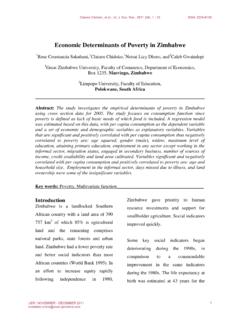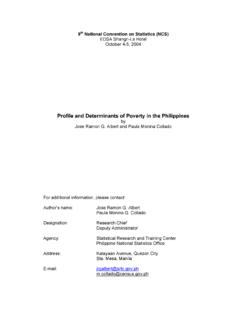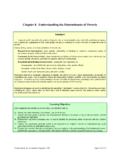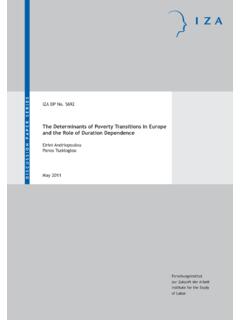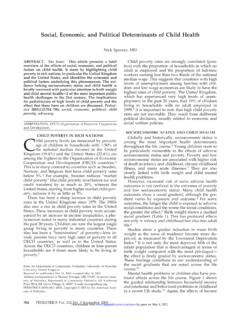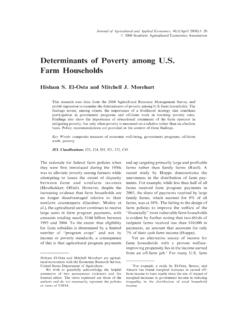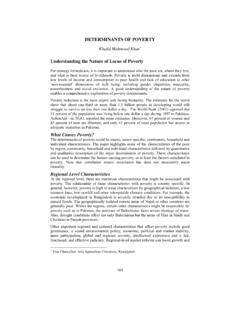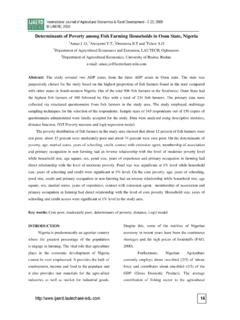Transcription of Determinants of Poverty Incidence among Rural Farmers in ...
1 American Journal of Rural Development, 2013, Vol. 1, No. 5, 131-137 Available online at Science and Education Publishing -5 Determinants of Poverty Incidence among Rural Farmers in Ondo State, Nigeria O. Igbalajobi2,3, Fatuase1,2,*, I. Ajibefun1,2 1 Department of Agricultural Technology, Rufus Giwa Polytechnic, Owo, Ondo State, Nigeria 2 Department of Agricultural and Resource Economics, Federal University of Technology, Akure, Ondo State, Nigeria 3 Department of Agricultural Economics and Extension, Joseph Ayo Babalola University (JABU), Ikeji Arakeji, Ilesa, Osun State, Nigeria *Corresponding author: Received August 30, 2013; Revised November 27, 2013; Accepted December 15, 2013 Abstract This study empirically analyzed the Determinants of Poverty among Rural Farmers in Ondo State, Nigeria. Primary data were used and a sample of 285 farm households through a multistage sampling technique was drawn from the study.
2 The data collected were analyzed using descriptive statistics, Foster-Greer-Thorbecke (FGT) Poverty measure, Gini coefficient and probit regression analysis. The findings revealed that , and of the respondents were male, married and no formal education respectively. The average household s age was over 50 years old which implies that the respondents were fairly old and experienced. of the respondents were actually poor while of the Poverty line ( USD) was needed to get out of Poverty . The result of Gini coefficient ( ) implies average level of income inequality among the respondents. The result of logit regression model indicated that age, gender, marital status, household size, access to credit, farm income and educational level of the respondents were the major Determinants of Poverty among Rural farm households.
3 It was further shown that reducing the frequency of eating per day, engaged in non-farming activities, praying and fasting, and seeking help from friends/relatives were the major strategies for coping with Poverty syndrome in the study area. Therefore, government should design holistic policies that will focus on the factors highlighted above in order to alleviate Poverty and improve the welfare of the Rural Farmers in the study area. Keywords: FGT, gini coefficient, Poverty measure, Rural Farmers , probit model Cite This Article: O. Igbalajobi, Fatuase, and I. Ajibefun, Determinants of Poverty Incidence among Rural Farmers in Ondo State, Nigeria. American Journal of Rural Development 1, no. 5 (2013): 131-137. doi: 1. Introduction To Agriculture has been a cornerstone in Nigeria economy and a major source of income to about 90% of the Rural dwellers.
4 With the abundance of human and natural resources, Nigeria Rural sector accommodates 70% of the nation s population and employs about 75% of the labour force as well as contributes 40% to the nation s GDP [1]. Despite its significant contribution to the life of the people, majority of Nigerians are faced with the consequences of Poverty : hunger, malnutrition, illiteracy, diseases, life of misery and squalor, low life expectancy, socio-political instability, bribery and corruption, crime, violence, prostitution, alcoholism, drugs addiction, frustration despair, disillusionment, pessimism and moral decadence [2]. Again, the ultimate goal of agricultural production plans in national development is to raise the standard of living and one of the important yardsticks for measuring standard of living is the average distribution income.
5 It has been reported that there is an existence of high level of income inequality in many low income countries of Sub-Saharan Africa in which Nigeria is inclusive [3,4]. This high income inequality has been also reported to produce an unfavourable environment for economic growth and development [5] vis- -vis impoverishes the system. Reference [6] reported that income inequality among households in Nigeria rose from in 2004 to in 2010, indicating greater income inequality during the period. The percentage change in inequality among the Rural and urban households between 2004 and 2010 was and respectively. The relationship between small farms and Poverty in Sub-Saharan Africa has been well established in the literature [7].
6 It has also been revealed that while the proportion of the population living in Poverty in smallholder farming is on the decrease in Asia, the proportion has increased in Sub-Saharan Africa in which Nigeria is inclusive [8]. The Poverty situation in Nigeria is quite disturbing as both the quantitative and qualitative measurements attest to the growing Incidence and increasing depth of Poverty in the country [9]. Poverty is a universal phenomenon that affects socio-economic and political well being of its victims whether in a developed or underdeveloped country, however, available statistics shows that Poverty in poor country is absolute and more pronounced in the Rural areas. In 2004, Nigeria s relative Poverty measurement stood at but increased to 69% (or 112,518,507 Nigerians) 132 American Journal of Rural Development in 2010.
7 The South-West geo-political zone (Ondo State inclusive) recorded the lowest Poverty rate ( ) among the six geo-political zones in Nigeria. It however remains a paradox despite the fact that the Nigerian economy is growing, the proportion of Nigerians living in Poverty is increasing every year, although it declined between 1985 and 1992, and 1996 and 2004. Distributing the population into extremely poor, moderately poor and non-poor as shown in Table 1, the proportion of the extremely poor increased from in 1980 to in 1996 and then came down to in 2004 before reaching in 2010. On the other hand, the proportion of non-poor was much higher in the country in 1980 ( ) compared to 1992 ( ). It dropped significantly in 1996 to , falling further in 2010 to 31% [6].
8 Table 1. Relative Poverty : Non-poor, moderate poor and the extremely poor (%), 1980 2010 Year Non-poor Moderate poor Extremely poor 1980 1985 1992 1996 2004 2010 Source: NBS, Harmonized Nigeria Living Standard Survey, 2010. Again, reference [10] reported that majority of the Rural poor are small-scale Farmers and the Poverty gap is becoming wider over the time which calls for corrective action. Thus, targeting of Rural farming households seems imperative in alleviating Poverty in Nigeria. Therefore, the specific drive of this study is to ascertain socio-economic characteristics of the farming households, assess the income inequality, Poverty status and Determinants of Poverty among the Rural farming households in Ondo State, Nigeria.
9 2. Methodology Study Area Figure 1. Map of Ondo State, Nigeria showing the Study Area This study was carried out in Ondo State, Nigeria. The State is situated between longitudes 40 151 E and 60 001E of the Greenwich meridian and latitudes 50 451N and 70 451 N which is the North of the equator in the Southwestern Nigeria. The State has 18 Local Government Areas with a population of about 3,440,000 of which the Rural population constitutes about million and land area of 14,606 km2 [11]. The climate of the area is highly favoured for the agrarian activities of her teeming population who grow crops such as cocoa, kola nut, palm tree and arable crops like maize, yam and cassava. The annual rainfall is between 1000mm and 1500mm with a high daily temperature of about 300C.
10 The vast majority of the population consists of peasant Farmers cultivating food and cash crops at a small-scale level. Livestock keeping is a minor occupation of the population of Ondo State dealing on goats, sheep, rabbits and fish farming. Other activities inculde trading and civil service [12]. Data Collection and Sampling Technique Primary data were used for this study which were collected through direct personal interview and structured questionnaire to obtain pertinent information for the study. Multistage sampling technique was used to select respondents. It was commenced by stratifying the State into three zones (north, central and south) based on administrative and political stratification. Each zone is made up of six local government areas.


